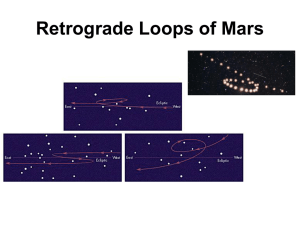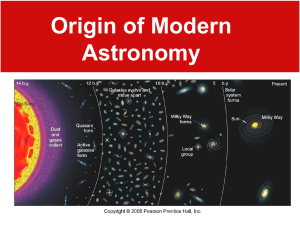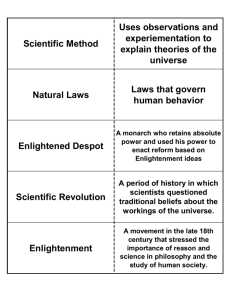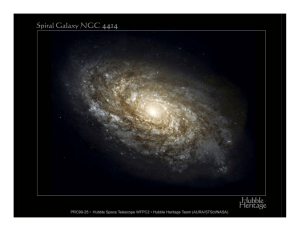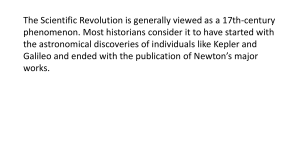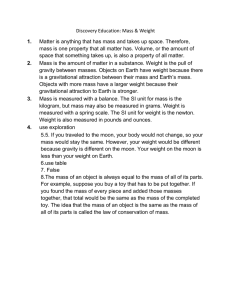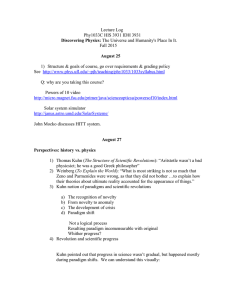Day-4
advertisement
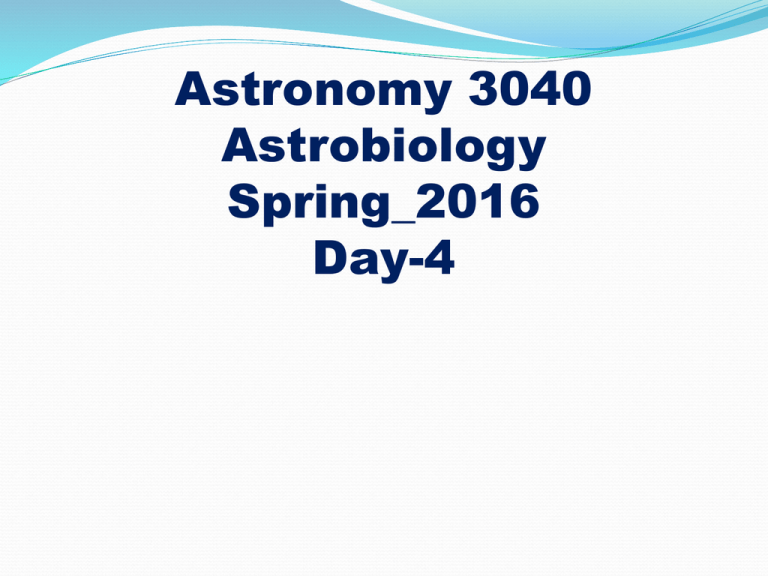
Astronomy 3040 Astrobiology Spring_2016 Day-4 Homework -1 Due Monday, Feb. 8 Chapter 2: 1, 3, 16 23, 24, 26 29, 30, 33 44 53, 54, 56 The appendices will be useful Life Beyond Earth - History If you go out to a dark location at night and look up (for a few years), what do you see? Sun rises and sets every day; moves across the sky Stars rise and set every day; move at a slightly different rate than Sun ==> Different stars visible at different times. Moon goes through monthly phases Planets meander in a “mysterious manner” No wind Conclusions? The Earth is flat and motionless. But we know the Sun controls life (day/night) The Moon influences tides Stars are useful for timing agriculture Lots of ties to daily life and ritual Greeks By ~500 B.C.E. the Greek society was well established and philosophy was began. Thayles (~624-546 BCE) origin of Greek science What is the Universe made of? Plato & Aristotle - 3 tenets of modern science. 1. Try to understand nature w/o supernatural expl. 2. Mathematics, geometry. 3. Power of reasoning from observations. ==> Models The Greek Universe Geocentric Celestial Sphere Ptolemaic model (100-170 A.D.) Epicycles Aristarchus (310-230 B.C.E.) Heliocentric – had it right! But disagreed with Aristotle Could not measure parallax! Heliocentric Universe Anti-intellectual fervor of 5th Century Libraries destroyed, The Church came to power Islamic scholars saved and translated much of Greek Contact with Hindu scholars, interaction with Chinese Nicholas Copernicus (1473-1543) Aware of Aristarchus's work Advocated the heliocentric view Tycho Brahe (1546-1601) Observational data All done with naked eye Heliocentric Universe Johannes Kepler (1571-1630) 3 Laws of Planetary Motion 1. Elliptical orbits, Sun at one focus 2. Equal area in equal time 3. P2 = ka3 (P in years, A in Astronomical Units) Heliocentric Universe Galileo Galilei (1564-1642) Laid foundations of modern physics Inertia (later explained by Newton's 1st law) Gravity First to use a telescope for astronomical purposes 1. Sunspots – Sun was not a perfect surface. 2. Craters on Moon – Moon was not a perfect surface. 3. Observations of thousands of stars not visible by eye. So stars more numerous than Tycho thought. 4. Geocentric Universe death Four moons orbiting Jupiter Phases of Venus Modern Science Isaac Newton (1642-1727) 1687 – Principia – precise math descriptions 3 Laws of Motion Universal Law of Gravitation Invented Calculus (to prove Kepler's Laws) Developed new type of telescope The Life Debate - Greeks Thayles - What is the Universe made of? 2 schools of thought Life must be everywhere, abundant No way, Jose! Anaximander – other Earths at other times. Greeks Atomists (many worlds) Aristotelians (Earth is unique, center of everything) The Life Debate – Copernican Revolution Copernicus proved the Earth was not the center Aristotle was wrong. Galileo – lunar features could be land & water. Kepler – moon had an atmosphere, and inhabited by intelligent beings. W. Herschel – assumed all planets inhabited. Lowell – canals on Mars. Based on hope & beliefs, not real evidence. Modern Science The Scientific Method. Observations Question Hypothesis Prediction Test Revise/More Predictions Modern Science OR The Eureka Moment. Look at Nature in a “general way” not looking for anything in specific Galileo Voyager 1, 2 - Europa Must overcome “personal experience” Gravity doesn't “work” because of drag. Hallmarks of Modern Science 1. Modern science seeks explanations for observed phenomena that rely solely on natural causes. 2. Science progresses through the creation and testing of models of nature that explain the observations as simply as possible. 3. A scientific model must make testable predictions about natural phenomena that would force us to revise or abandon the model if the predictions do not agree with observations. Modern Science Occam's Razor William of Occam (1285 - 1349) K.I.S.S. Verifiable Observations UFOs vs. Einstein Theory of Relativity Science, Nonscience, Pseudoscience Objectivity Scientific Theory Newton, Darwin, Einstein Gravity 1666 – Newton Apple & tree ==> Moon & Earth Universal Law of Gravitation Every mass attracts every other mass through a force called gravity. Directly proportional to product of masses. Inversely proportional to square of distance between them. G = 6.67 X 10-11 m3/kgs2 Force is in Newtons F = ma (kgm/s2) Gravity Einstein ... space-time But, do we REALLY understand gravity?

